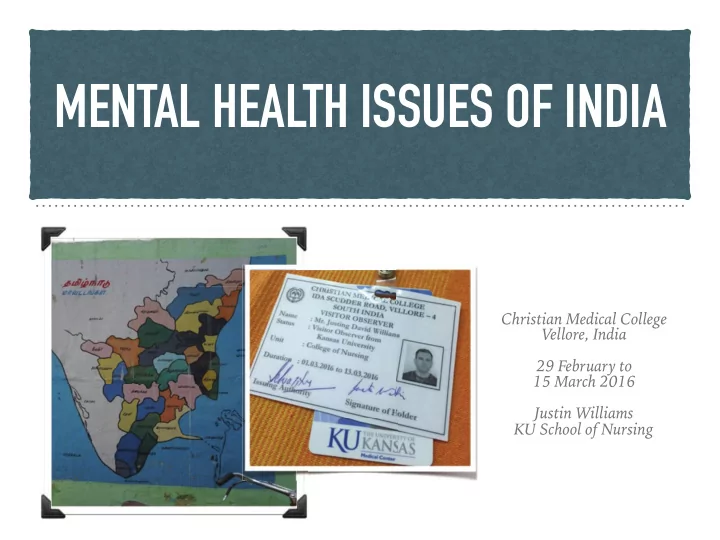

MENTAL HEALTH ISSUES OF INDIA Christian Medical College Vellore, India 29 February to 15 March 2016 Justin Williams KU School of Nursing
OBJECTIVES ➤ Examine community health interventions established by Christian Medical College (CMC), Vellore ➤ Experience Psychiatric Nursing and observe evidence based practices for treatment of mental health diagnoses ➤ Build relationships with health care professionals at CMC ➤ Assimilate in the culture of India while gaining competence of culture to better understand culturally exclusive interventions
BACKGROUND INFORMATION ➤ Population of India: 1.241 billion (2011) ➤ India constitutes 2.4% of the total land area in the world while being occupied by 16.87% of the population ➤ India has the highest rate of suicide at a mortality rate of 21.1 per 100,000 people (World Health Organization, 2014) ➤ Indian culture relies heavily upon their family structures to provide for needs of women, children, and ill ➤ This is true for mental health treatment as well, families provide much of the care for patients with mental health diagnoses (Avasthi, 2010)
BACKGROUND INFORMATION (CONT.) ➤ Spirituality very important in India ➤ Majority are Hindu (81%) ➤ Followed by Muslims (13%), Christians (>3%), Sikh (2%), Buddhists (>1%), and Jains (>1%) (CultureGrams, 2014) ➤ Income levels vary ➤ Vellore (Southern India) - lower and middle class ➤ Delhi (Northern India) - middle to upper class ➤ Much of healthcare provided by government programs in partnership with NGOs, NO OVERLAP OF SERVICES
CHRISTIAN MEDICAL COLLEGE, VELLORE ➤ Private Hospital ➤ Works well with government healthcare services, partners ➤ Started in 1900 by Ida Scudder, an American Missionary ➤ Three Knocks… ➤ E ff orts in advancing women through medicine and nursing
DEPARTMENT OF PSYCHIATRY ➤ Outpatient Clinic ➤ Can see up to 200-400 patients per day ➤ 2 adult, 1 children/adolescent, and 1 autism team ➤ Inpatient wards ➤ Three wards, income dependent ➤ Acute care room ➤ All provide patient and family housing; floor mat to bed ➤ No patient identifiers, reduce stigma
MENTAL HEALTH ISSUES IN INDIA ➤ Depression, Schizophrenia, Bipolar, Obsessive-Compulsive behaviors, emotional and marital problems (adjustment disorder) ➤ Addiction (primarily alcohol) ➤ Suicide seen primarily with addiction and adjustment disorders ➤ Lack of proper treatment due to lack of access to resources ➤ Transportation ➤ Financial burden ➤ Families do the best they can based on their level of understanding ➤ Conflict of medicine versus homeopathy (D. Kattula, Personal Communication, 2016) ➤ Additionally conflicts arise with insistence of no overlap of services between NGOs and government programs
Alcohol Prevalence Inadequate Care Culture Conflict
SYSTEM INTERVENTIONS ➤ Mental Health Bill of 2013 (Pending) ➤ Decriminalizes suicide ➤ Ensures rights of those with mental illness ➤ Right to care (provided or funded by government) ➤ Right to legal counsel ➤ Greater oversight of mental health facilities ➤ Additional training for law enforcement ➤ Mental Health Act, 1987 (Current) ➤ Terminology changes ➤ Oversight begins of mental health institutions
COMMUNITY INTERVENTIONS ! D estigmatizing mental health disorders in society ! Moving away from belief that mental health issues stem from supernatural causes while respecting culture ! Social and biological understanding of mental health is growing, however many still believe there is a supernatural aspect to mental health disorders (Saravanan et al., 2008) ! Reporting suicides as cause of death rather than natural causes. Vellore rates higher: 95 per 100,000; due to accurate reporting from community (Manoranjitham et al., 2010). ! Greater awareness of human rights violations ! Chaining loved ones ! Erwadi mental asylum tragedy ! Basic needs must be met first ! Water, Sanitation, Social Justice
INTERVENTIONS IN PRACTICE AT CMC (INDIVIDUAL LEVEL) ➤ Removing stigma ➤ No patient identifiers ➤ No gowns ➤ No restrictions placed on movement ➤ Family integration into psychiatric care ➤ Family living space provided for all inpatient wards ➤ Family expected to provide personal care and food for patients ➤ Inclusion in psychotherapy sessions, history/interview, discussion of care plan ➤ Removing barriers ➤ Home visits ➤ Reduced cost for medications and services provided, decided by practitioner
INPATIENT WARD
Occupational Therapy - Home Visits - Therapeutic Environment
CONCLUSIONS ➤ CMC is an example of inpatient mental health services that works. ➤ While the United States moved away from inpatient facilities due to abuses; CMC is an example of how inpatient treatment can work even long term. ➤ Family integration into care of mental health patients is paramount and is working at CMC (D. Kattula, Personal Communication, 2016). ➤ Data collection is something CMC would like to improve to provide evidence of their model of care ➤ Case studies are proving the model works though ➤ India is culturally accepting of this less private approach (Would this work in the United States? After destigmatization?) ➤ Conflicts arise due to varies beliefs and system issues within India
MOST PROFOUND CLINICAL EXPERIENCE 2 Deaths first day & 1 Suicide attempt by pesticide
MOST PROFOUND CULTURAL EXPERIENCE Cultural Assimilation
REFERENCES Avasthi, A. (2010). Preserve and strengthen family to promote mental health. Indian journal of psychiatry , 52 (2), 113. Christian Medical College. (2009). Psychiatry - Mental health centre. Retrieved from http://www.cmch-vellore.edu/PatPsychiatry/tabid/287/Default.aspx CultureGrams. (2014). India . Provo, Utah: ProQuest. Manoranjitham, S. D., Rajkumar, A. P ., Thangadurai, P ., Prasad, J., Jayakaran, R., & Jacob, K. S. (2010). Risk factors for suicide in rural south India. The British Journal of Psychiatry , 196 (1), 26-30. Saravanan, B., Jacob, K. S., Deepak, M. G., Prince, M., David, A. S., & Bhugra, D. (2008). Perceptions about psychosis and psychiatric services: a qualitative study from Vellore, India. Social Psychiatry and Psychiatric Epidemiology , 43 (3), 231-238. World Health Organization. (2014, September 4). First WHO report on suicide prevention [Press release]. Retrieved from http://www.who.int/mediacentre/ news/releases/2014/suicide-prevention-report/en/
Recommend
More recommend